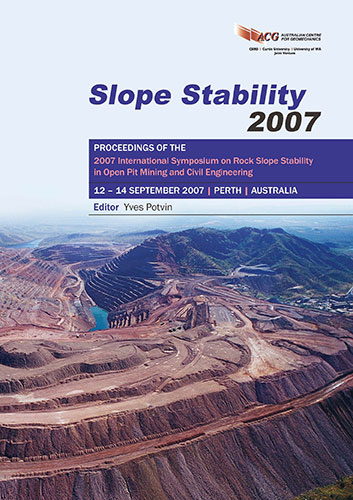Pit Slope Design and Structural Analysis at the Jericho Diamond Mine Utilising Digital Photogrammetric Mapping

|
Authors: Mathis, JI |
DOI https://doi.org/10.36487/ACG_repo/708_4
Cite As:
Mathis, JI 2007, 'Pit Slope Design and Structural Analysis at the Jericho Diamond Mine Utilising Digital Photogrammetric Mapping', in Y Potvin (ed.), Slope Stability 2007: Proceedings of the 2007 International Symposium on Rock Slope Stability in Open Pit Mining and Civil Engineering, Australian Centre for Geomechanics, Perth, pp. 93-104, https://doi.org/10.36487/ACG_repo/708_4
Abstract:
Characterization of the spatial characteristics of geologic structures (continuity, centre density, and orientation) is of tremendous importance to rock slope design. While rock fabric mapping has been utilized for bench design, collection of data sufficient in both accuracy and quantity to characterize the fabric spatial characteristics for geotechnical design has always been a problem. It is even more difficult to collect spatial characteristic data relating to intermediate scale faults, shears, and continuous joints. This has hindered the application of statistical structural modelling techniques to interramp and overall slope design. The advent of digital photogrammetric methods allows one to overcome many of the slope scale and data coverage limitations that restricted such methods. The Jericho Diamond Mine, owned and operated by Tahera Diamond Corporation, is located in Nunavut, Canada. The host rocks for the diamondiferous kimberlite consist primarily of massive granitic rocks. Collection of adequate statistically valid samples of the spatial characteristics of both the smaller scale discontinuities (joints) and larger scale discontinuities (faults/shears) is difficult utilizing standard mapping techniques as the mean trace length of the joints can approach the presently mined bench height. Instead, digital photogrammetric mapping of the pit walls was conducted utilizing ADAM Technology's 3DM Analyst photogrammetric software. The resulting DTM’s, mapped discontinuities, and draped images were imported into Maptek’s Vulcan software where major structural zones/faults were modelled. Zostrich Geotechnical’s discontinuity data reduction and modelling software was applied to statistically quantify/predict bench face angle distributions and to determine the probability of overall and interramp pit wall failures.
References:
Mathis, J.I. and Todd, J.K. (2002) Improving double bench face performance at the Ekati diamond mine, Presented at
the CIM convention, Vancouver, B.C., Canada, April 2002.
Mathis, J.I. (1988) Development and verification of a three-dimensional rock joint model. Doctoral Thesis 1988:63 D,
University of Luleå, Sweden, May.
Pit Slope Design and Structural Analysis at the Jericho Diamond Mine Utilising Digital Photogrammetric Mapping J.I. Mathis
104 Slope Stability 2007, Perth, Australia
© Copyright 2025, Australian Centre for Geomechanics (ACG), The University of Western Australia. All rights reserved.
View copyright/legal information
Please direct any queries or error reports to repository-acg@uwa.edu.au
View copyright/legal information
Please direct any queries or error reports to repository-acg@uwa.edu.au